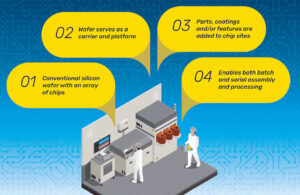Heterogenous integration can help device developers fit more innovative technologies into smaller devices.
By Dick Otte, Promex

[Image courtesy of Promex Industries]
The electronics industry began using the term heterogeneous integration (HI) about five years ago to describe a new approach to building semiconductor devices that would allow for greater density and capability. The legacy approach to making transistors, lines, and spaces smaller was becoming more difficult due to the limitations of lithography. Thus, a new idea was spawned: adding material and/or parts to die on conventional complementary metal-oxide semiconductor (CMOS) wafers to add functionality beyond what is inherent in silicon CMOS.
John Bowers at the University of California Santa Barbara pioneered an early HI example, placing a small piece of indium phosphide onto a waveguide fabricated on a silicon wafer. Doing so made it possible to build a laser on a CMOS wafer, something that was not possible with silicon alone because silicon does not have a bandgap. The result was a chip that generated light on die that could be used for a variety of purposes.
In recent years, the idea of adding materials and parts to a conventional CMOS wafer has spread to the point where now a wide variety of parts are combined on wafer to greatly increase the functions available at the die level. Today’s CMOS wafers often serve as a platform on which parts and materials are combined with CMOS electronics to add functionality. The term HI is now generally used to describe electronic devices that incorporate non-electronic parts.
Heterogenous integration in the medical industry
Examples of devices with non-electronic parts combined with semiconductors include the pacemaker (an early application), the implanted defibrillator, the oximeter, and nerve stimulators. HI does not inherently provide new functionality, but enables increased functionality in smaller, lower power, and often lower-cost devices. Integration enables devices to perform in spaces where large devices are not viable.
Medical applications of HI devices include diagnosis and treatment of conditions through interaction with the patient. Electronics do not directly measure or deliver medical functionality. Instead, electronic power sensors and/or actuators act upon living things to gather, process, and report information. HI enables this combination.
Also, when highly functional, minimally invasive tools and devices are required, with a premium on quality, functionality, and smaller sizes (especially for devices that go into the body, even temporarily), HI can fulfill these requirements.
Communications functionality can also be added to medical devices using HI, enabling connection between the device/patient and the outside world. The information can be sent to the cloud where it is available for analysis (often using AI) to provide diagnosis or treatment. Adding integrated communication may be the most important capability that HI can add to a device.
Implantable devices
HI can reduce the physical size of a device to make it implantable. Especially when it must function for years, an implantable has very demanding requirements that call for careful engineering, material selection and thorough testing.
Modern CMOS devices can have billions of transistors per cubic milimeter and consume little power, attributes that are critical for implantable devices. This enhanced computing also enables a large amount of analysis and storage of information within a small space.
Technical methods to communicate with implanted devices include inductive coupling, infrared light, radiofrequency (RF) and even ultrasound. Some of these technologies enable charging a battery that is either in an implanted device, like a pacemaker, or worn on the body, like a neuromodulation device.
Disposable invasive devices
This class of device includes surgical tools like laparoscopic cameras and catheters used for diagnosis or treatment. These devices may be inserted into the body multiple times but are not left in the body for an extended period. They must be sterilized between uses and be highly dependable for repeated use. Disposable devices often benefit from the inclusion of heterogeneously integrated electronics to gather information from sensors, process information, and report results.
Diagnostic devices
Medical practitioners historically have a variety of tools to gather information to diagnose conditions. Many of these devices are stand alone, special purpose “boxes” that do not communicate with anything other than the user, are complex to use, and expensive. HI enhances device usability by enabling acquisition of increasingly rich data (temperature, blood pressure, sugar level, pressure, acidity, protein types, etc.) gathered by adding suitable sensors, onboard computing for data analysis and communication to the practitioner, patient or the cloud. HI makes devices smaller and enables higher-fidelity sensors, in many cases making novel, real-time measurements possible.
Other diagnostic devices enabled by HI employ single-use cartridges with onboard chemistry to detect the presence of a target in blood, urine or similar samples. collected from a patient. Often, engineered chemistries are deposited on the surface of a CMOS wafer at select points. Presence of a target that the chemistry is designed to detect activates the CMOS’ electronics in some manner, such as a change in electrical conductivity and/or charge density, emission of light, or changes in color or magnetic properties. Electronics not only detect the phenomena but can analyze and communicate information about the targets to the user of the device or to the cloud for comparison against library “fingerprint” datasets.
Adding functions to a medical device used to happen by assembling the appropriate parts using nuts and bolts, press fits and glues. The results were devices that were large, with high part and assembly costs, requiring significant power to operate. HI enables devices that are physically smaller, able to be manufactured at the cost and scale of microelectronics, consuming less power while performing similar or enhanced functions.
HI is a modern manufacturing method mastered by assemblers with roots in the semiconductor industry, where HI was born. While it is a highly specialized practice that requires modifications and customizations of manufacturing approaches, the end results benefit the medical and biotech community, practitioners, innovators and patients.
The term HI is also now used generally to describe electronic devices that incorporate non-electronic parts. The infographic below illustrates some common combinations.

Today, a large variety of parts and materials can be added to electronics on a CMOS wafer.
Assembling non-electronic with electronic parts through HI requires special skill and experience. Parts can be damaged if integrated using standard electronic assembly methods, such as reflow soldering at 260°C, washing in water, and exposure to ultraviolet curing conditions. Knowledge of proper assembly materials, joining methods, and manufacturing process/workflows is critical.
Below are some considerations of building an HI device that incorporates a particular addition, along with process changes needed to accommodate HI additions to an electronic device.
Non-electronic part added: InP, SiGe, GaN, SiN
- Function added: Lasting, efficient O-E conversion, power handling
- Characteristic to accommodate: Added in semiconductor fab
- Accommodation and assembly process solution: New fab processes need to be developed
Non-electronic part added: Optical devices
- Function added: Transmit info with photons, cameras, Lidar, detect wavelength/s of specific species, utilize fluorescence
- Characteristics to accommodate: Maintain transparency and mechanical stability during manufacturing and lifetime of use
- Accommodations and assembly process solutions: Build in cleanroom to minimize particles that scatter light, deteriorate images; Highly accurate part placement; Ensure organics do not have volatiles that redeposit on optics over time; Adhesives and materials must not “yellow” over time; Utilize high modulus adhesives with low CTE; Ensure organics do not bleed onto adhesive, solder or wire bond surfaces
Non-electronic part added: MEMS Devices
- Function added: Provide micro mechanical motion
- Characteristics to accommodate: Fragile, susceptible to scratches; Susceptible to particles and contamination; Susceptible to ESD
- Accommodations and assembly process solutions: Customized handling methods and tools; Build in class 5 to 7 cleanroom, minimize organics in the package; Build in ESD controlled environment
Non-electronic part added: Fluid channels
- Function added: Ability to utilize gas or liquid samples
- Characteristics to accommodate: Must not leak; Laminar flow required
- Accommodations and assembly process solutions: Careful deposition of sealants; Smooth well control shape to channels
Non-electronic part added: Mechanical parts
- Function added: Mounting points, mechanical structure
- Characteristic to accommodate: Must not interfere with wafer functions
- Accommodation and assembly process solution: Careful automated dispensing of adhesives and placement of parts
Non-electronic part added: Chemistry on surface
- Function added: Ability to detect specific compounds
- Characteristics to accommodate: Must keep dry; May deteriorate if temperature is over 40°C; Susceptible to scratching; UV sensitive
- Accommodations and assembly process solutions: Solder with vacuum, formic acid or forming gas vs flux that requires washing and temporarily protect part from wash water with tape, etc; .Process at less than 40°C; Specialized fixtures and handling tools for use in transporting items; Shield sensitive surfaces from UV when used

Dick Otte [Photo courtesy of Promex Industries]
Dick Otte is president and CEO of Promex Industries, a provider of microelectronic assembly for the medical and biotechnology markets. Otte has made significant contributions to electronics manufacturing technology and processes, mentored dozens of leaders in the industry, and managed teams of design, development, and manufacturing engineers and employees. He has more than 75 patents from throughout the world and holds BSEE and MSEE degrees from MIT and an MBA from Harvard University.
How to submit a contribution to MDO
The opinions expressed in this blog post are the author’s only and do not necessarily reflect those of Medical Design & Outsourcing or its employees.